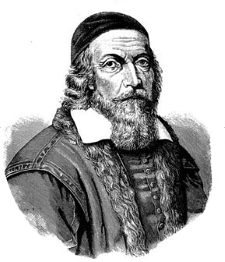Our namesake, John Amos Comenius (Czech: Jan Amos Komenský; Latinized: Ioannes Amos Comenius; 28 March 1592 – 15 November 1670), is considered the “Father of Modern Education”. Education for Comenius stretches beyond the boundaries of the classroom and encompasses all of life. Komensky Communications develops information in accordance with these principles.
To me, Comenius represents engagement. He determined that people learn best when they are engaged in the activity.

His thoughts are foundational–structuring information so that it is accessible to a specific audience. He introduced several educational concepts and innovations including:
- Pictorial textbooks written in native languages instead of Latin
- Teaching based in gradual development from simple to more comprehensive concepts
- Lifelong learning with a focus on logical thinking over dull memorization
- Equal opportunity for impoverished children
- Education for women
- Universal and practical instruction
Comenius’s great interest was in furthering Sir Francis Bacon’s attempt at organizing all human knowledge. He became one of the leaders in the encyclopædic or pansophic movement of the seventeenth century.
Comenius produced a series of textbooks that express the pansophic ideas. In these textbooks, he attempts to organize the entire field of human knowledge to bring it within the grasp of every student. In addition, Comenius attempted to design a language in which false statements were inexpressible.
The first of these textbooks to be published was the Janua Linguarum Reserata (The Gate of Tongues Unlocked), issued in 1631. This was followed by a more elementary text, the Vestibulum, and a more advanced one, the Atrium, and other texts. In 1658 the Orbis Pictus was published, probably the most renowned and most widely circulated of school textbooks. It was also the first successful application of illustrations used for teaching.
These texts were all based on the same fundamental ideas:
- Learn foreign languages through the vernacular
- Obtain ideas through objects rather than words
- Start with objects most familiar to the student to introduce him to both the new language and the more remote world of objects
- Give the student a comprehensive knowledge of his environment, physical and social, as well as instruction in religious, moral, and classical subjects
- Make this acquisition of a compendium of knowledge a pleasure rather than a task
- Make instruction universal
In his Great Didactic, Comenius notes:
The universal requirements of teaching and learning, that is to say, a method of teaching and of learning with such certainty that the desired result must follow out of necessity.
And he follows with some principles that he observed in nature which are applicable to education:
- Nature observes a suitable time
- Nature prepares the material, before she begins to give it form
- Nature chooses a fit subject to act upon, or first submits one to a suitable treatment in order to make it fit
- Nature is not confused in its operations, but in its forward progress advances distinctly from one point to another
- In all the operations of nature, development is from within
- Nature, in its formative processes, begins with the universal and ends with the particular
- Nature makes no leaps, but proceeds step by step
- If nature commences anything, it does not leave off until the operation is completed
- Nature carefully avoids obstacles and things likely to cause hurt
Comenius’s foundational work gives us a framework on how to structure information so that it is addressed to the right audience at the right time. Information grows with the audience and the needs. The audience is not forced to contort and struggle through the information.
I intend to examine and discuss how we can continue in this light.